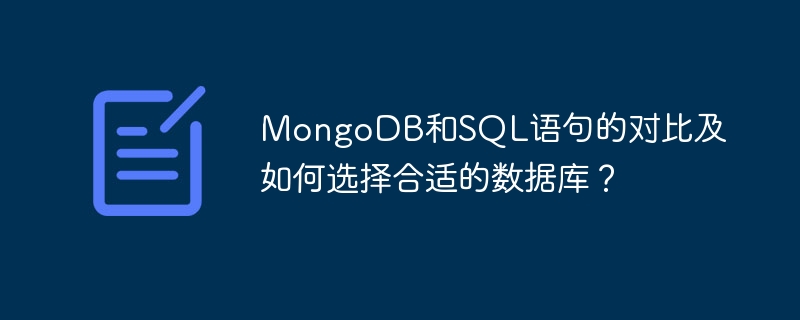Comparison of MongoDB and SQL statements and how to choose the appropriate database?
- 王林Original
- 2023-12-17 22:58:05908browse

In today's world of software development, choosing the right database is crucial to the success of your project. When choosing a database, developers usually face two main choices: relational databases and non-relational databases. MongoDB and SQL are representatives of these two types of databases. This article will conduct a detailed comparison between them and provide some suggestions on how to choose the appropriate database.
Comparison of MongoDB and SQL
- Data model
MongoDB is a document database that uses BSON (Binary JSON) format to store data. It uses collections to store documents. Each document consists of key-value pairs or key-array-value pairs. MongoDB's document model is very advantageous for unstructured data because it can add or delete fields freely without having to define a data template in advance like a relational database.
SQL is a relational database that uses tables to store records. Each table contains a set of rows, each with the same columns. In SQL, the types of data columns must be explicitly determined when defining the table, and if you want to add or remove columns, you need to modify the table.
- Query method
MongoDB’s query method is very different from traditional SQL query. MongoDB uses JSON-formatted query statements, called "query documents", using a type called "query expressions" whose syntax is similar to JavaScript. Because MongoDB's document structure is very flexible, complex nested and mixed queries can be used to flexibly retrieve data.
SQL uses Structured Query Language (Structured Query Language) to execute queries by writing SQL query statements. SQL is particularly good at executing complex connection queries between tables, and supports advanced query statements including COUNT, GROUP BY, HAVING, etc.
The following is a simple comparison:
MongoDB query:
db.users.find({ age: { $lt: 30 } })SQL query:
SELECT * FROM users WHERE age < 30;
- Data consistency
MongoDB is an "eventually consistent" database, which means that it may take some time for updates or deletions of documents in a collection to be seen by all nodes. This will lead to document inconsistencies. For example, some nodes can access the version before the update, while some nodes can access the version after the update.
SQL is a strongly consistent database. Each transaction must ensure that the status of all related tables has been modified, and at the end of the transaction, the database status is a consistent state.
- Scalability
MongoDB uses sharding to achieve horizontal expansion. In MongoDB, data can be divided into several blocks and then horizontally distributed on several machines, making the data evenly distributed and allowing queries to be executed in parallel, thereby improving performance and forming a highly available structure.
SQL databases usually achieve scalability by using master-slave replication. Based on the Master-Slave architecture, only the Master node performs write operations (Insert, Update, Delete), and the Slave node is mainly responsible for read operations (Select). When the Master node is unavailable, service availability is ensured by electing a new Master node.
How to choose a suitable database?
Choosing the appropriate database depends on your application scenarios and needs. Before choosing MongoDB or SQL, you need to think about the data types, data access patterns, and performance requirements involved in your application, and then consider the following aspects:
- Data structure
MongoDB and SQL have different ways of handling different data types and data structures, so consider the types of data structures used in your application when choosing. If your category structure is relatively simple, you can choose a SQL database. If you need flexible, unstructured data storage, you should choose MongoDB.
- Database Performance
Performance considerations are a key factor when deciding which database is best for your application. When choosing a database, be sure to check the read and write speed of the database, and also pay attention to issues such as data consistency and transaction processing.
- Scalability
If your application requires higher scalability, then you need to choose a database that can more easily expand horizontally and vertically. , MongoDB is a good choice.
Finally, the following is a simple application, code examples implemented on MongoDB and SQL respectively, to help readers better understand different database implementations:
Implemented in MongoDB:
const MongoClient = require('mongodb').MongoClient;
const assert = require('assert');
const url = 'mongodb://localhost:27017';
const dbName = 'myproject';
const client = new MongoClient(url);
client.connect(function(err) {
assert.equal(null, err);
console.log("Connected successfully to server");
const db = client.db(dbName);
const collection = db.collection('documents');
const insertDocuments = function(callback) {
const collection = db.collection('documents');
collection.insertMany([
{a : 1}, {a : 2}, {a : 3}
], function(err, result) {
assert.equal(err, null);
assert.equal(3, result.result.n);
assert.equal(3, result.ops.length);
console.log("Inserted 3 documents into the collection");
callback(result);
});
}
const findDocuments = function(callback) {
const collection = db.collection('documents');
collection.find({}).toArray(function(err, docs) {
assert.equal(err, null);
console.log("Found the following records");
console.log(docs)
callback(docs);
});
}
insertDocuments(function() {
findDocuments(function() {
client.close();
});
});
});Implemented in SQL:
const mysql = require('mysql');
const connection = mysql.createConnection({
host: 'localhost',
user: 'root',
password: 'password',
database: 'mydb'
});
connection.connect();
connection.query('INSERT INTO mytable (id, name) VALUES (1, "foo")', function (error, results, fields) {
if (error) throw error;
console.log('The solution is: ', results[0].solution);
});
connection.end();Summary
When choosing a suitable database, you need to consider many factors, such as: data type, data access mode, performance requirements and data consistency sex. In this article, we compare the differences between MongoDB and SQL and provide some simple code examples to help you understand the different database implementations. Which database you ultimately choose depends on your application's needs and goals.
The above is the detailed content of Comparison of MongoDB and SQL statements and how to choose the appropriate database?. For more information, please follow other related articles on the PHP Chinese website!

